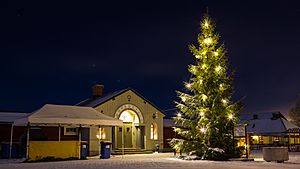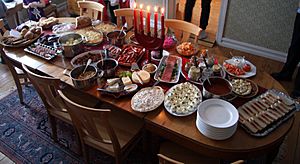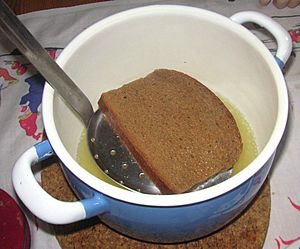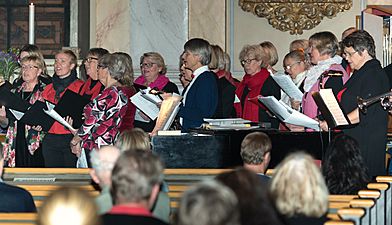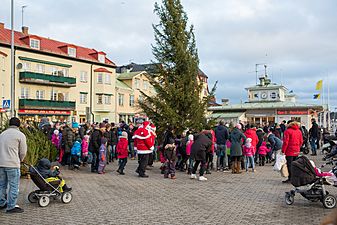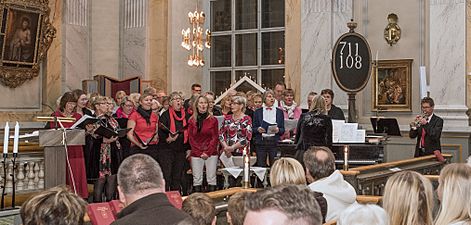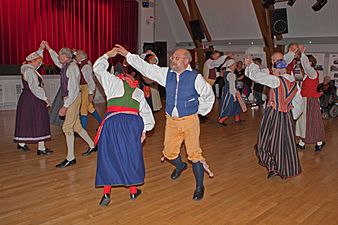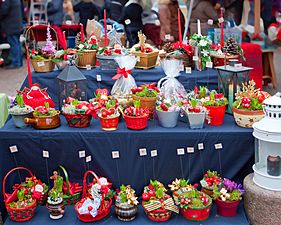Christmas in Sweden facts for kids
Quick facts for kids Christmas in Sweden |
|
|---|---|
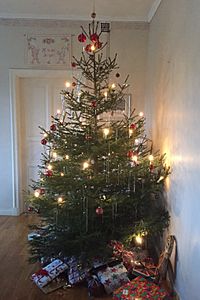
Christmas tree in Sweden in 2017
|
|
| Observed by | Christians, including non-believing Christians |
| Liturgical color | White |
| Date | 24 December |
| Next time | 24 December 2025 |
| Frequency | annual |
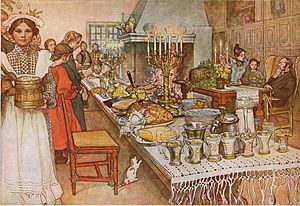
Christmas in Sweden is called jul (pronounced "yool"). It is celebrated throughout December. The festivities traditionally last until Saint Knut's Day on January 13.
The main celebration happens on Christmas Eve, December 24. This is when many families exchange gifts. Another important day is the Feast of St. Lucy on December 13, celebrated during Advent.
Swedish Christmas traditions are a mix of old local customs and ideas from other countries. Most Swedes celebrate Christmas in a similar way today. Many older local traditions have slowly faded away.
Contents
History of Swedish Christmas
The word "Jul" has old Germanic roots. Its exact origin is not fully clear. Around the year 600, it appeared in a Gothic calendar with Christian writings. By the year 900, people would "Dricka Jul" (Drink Jul). This celebration marked the winter solstice. This is when the days start getting longer again after the shortest day of the year.
Ancient Winter Celebrations
In ancient Nordic times, there was a "midvinterblot" rite. This was a special ceremony held in mid-winter. It might have been at the same time as Jul, or in mid-January. People would offer things to the gods, especially Odin. They hoped for good crops. When Sweden became Christian, these old rites were stopped.
The idea of celebrating Christmas in late December is very old. It combines the Old Norse Jul celebration with the Christian celebration. The Christian holiday remembers the birth of Jesus Christ. These two traditions merged about 800 years after the first Christian Christmas records in 333.
Food and Drink Traditions
Old Norse writings often describe the pagan Jul as "to drink jul." Eating and drinking well was a big part of the midwinter celebration. People would bake and make ale and mead. These were important preparations. Old calendars and stone carvings show this celebration with a barrel of ale or a drinking horn. So, the focus on food and drink was originally a pagan part of Christmas.
The Christmas tree tradition came from Germany in the 1880s. Before that, people gave joke presents, often a log of wood. Later, these were replaced by Christmas gifts. These gifts were brought by the Yule goat (Julbocken) or, more recently, Santa Claus (Jultomten).
Christmas Traditions Today
December Preparations
Christmas celebrations in Sweden usually begin with the first Advent. This is in late November. Stores start selling Christmas decorations and julmust (a special Christmas soda) even earlier. Many people start planning their Christmas and buying gifts then.
On December 1st, the first episode of the Christmas calendar airs. This is on TV and radio. December 13 is Lucia Day. Many children and adults dress up and have parades. They do this in preschools, schools, and companies. The third and fourth Advent Sundays are important for families. Many preparations are done then. Baking and cooking are common activities. Decorating the home is also a big part of it. People often do a lot of food shopping in the weeks before the holidays. They also buy the last Christmas gifts.
Most preschools and schools start their Christmas break between December 17 and 22. Many workplaces start later, between December 20 and 23. The exact start depends on which day Christmas Eve falls. The last few days before Christmas Eve are very busy. People prepare most of the food. They also buy and decorate the Christmas tree and wrap presents. Stores and malls are usually very crowded during these days.
After Christmas Eve
After Christmas Eve, there are two public holidays. These are juldagen (Christmas Day) and annandag jul (Boxing Day). Most families are off work. Some workplaces might start again before New Year's Eve. After New Year's Eve, schools usually have at least another week off. Workplaces often start a few days after the new year.
Many Swedes attend church services. They might go on Advent Sunday. Some go to Midnight Mass on December 24. Others attend the Christmas Matins (Julotta) early on Christmas Day.
The Christmas Tree
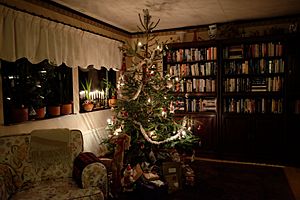
The Christmas tree tradition started in Germany in the 1500s. In the 1600s and 1700s, trees began to be decorated with candles. The first Swedish Christmas trees had real candles and treats. These treats included fruit and candy. Apples were often hung to make the branches level for candles. Soon, families made their own decorations. They used paper and straw. Some families built a Ljuskrona (light crown). It was decorated with cut paper.
By the 1880s, store-bought decorations were available. The best ones came from Germany. Families choose different days to decorate their trees. Most have them ready by December 13. They are usually taken down by January 13. Common decorations today include: baubles, candles, apples, Swedish flags, small gnomes, and straw ornaments. Homes might also have red tulips. The smell of pepparkakor (gingerbread cookies) fills the air. These cookies are often shaped like hearts, stars, or goats.
Saint Knut's Day (January 13) marks the end of the Swedish Christmas and holiday season. Children often celebrate it with a Knut's party.
Jultomten, the Christmas Gnome
Jultomten, or just tomten, is the one who brings gifts. He comes on Julafton (Christmas Eve). The gifts are called julklappar. They are a modern version of the old Yule log tradition. Jultomten does not come down the chimney. He delivers the gifts in person. Often, an older family member secretly dresses up as Jultomten. They knock on the door with a sack of gifts.
The modern Jultomte is a mix of two characters. One is the old Swedish Tomte. The other is Santa Claus, who came from the Netherlands. A Tomte is a small, gnome-like spirit. He lives on a farm and takes care of it. He might give gifts if the farmers treat him well. The tomte is thought to be a spirit of previous generations. Despite different roots, the Jultomte looks like the Santa Claus we know today.
Christmas Food and Drink
Christmas foods in Sweden used to vary by region. Now, many dishes are similar everywhere. This is because stores offer the same foods. Also, many ready-made foods are available. Few people make their own hams or sausages anymore.
The main meal on Christmas Eve is a buffet called julbord. It has many classic dishes. A fancy restaurant might serve over fifty different dishes. A family julbord is usually smaller.
A traditional julbord is eaten in several courses.
- The first courses are usually fish. This includes pickled herrings with sour cream. There are also different kinds of salmon. Hot fish dishes like lutfisk are also served.
- The next course has cold sliced meats. The most important is the Christmas ham (julskinka) with mustard. Other meats include smoked sausages and liver pâté. These are often served with cheese and crispbread.
- Then come the warm dishes (småvarmt). This often starts with dopp i grytan. This means dipping bread in the ham stock. Other warm dishes include Swedish meatballs (köttbullar). There are also small fried sausages (prinskorv) and roasted pork ribs. A popular dish is Janssons frestelse. This is a warm potato casserole with cream, onion, and sprats. Side dishes include beetroot salad and stewed cabbage.
The meal ends with a cheese plate and desserts. Cheeses include västerbottenost and Christmas edammer. Desserts include struvor, klenäts, polkagrisar (peppermint candy), knäck (toffee), and ischoklad (chocolate candy). There are also saffron buns, gingerbread cookies, and marzipan figures. The most important dessert is rice pudding (risgrynsgröt). It is sprinkled with cinnamon. An almond is often hidden in the pudding. Whoever finds it gets a small prize or good luck.
Local and family specialties are also common. These might include isterband (sausage) or saffranspannkaka (saffron pancake).
The main drink is julmust, a special Christmas soda. It is served throughout the holiday.
The Christmas ham is usually boiled or baked. Then it is glazed with egg, breadcrumbs, and mustard.
Lutefisk is dried fish prepared with lye. It is served with boiled potatoes and a white or mustard sauce. Some families eat lutfisk on a different day.
Many Swedes simply mix the dishes they like from the julbord. This is because many families prepare a smaller julbord with just their favorite items.
Julbord is served in restaurants from early December until just before Christmas. In homes, it can be served until Epiphany. Glögg (mulled wine), gingerbread cookies, and saffron buns are enjoyed all through December.
Gallery
See also



